Corporate Social Responsibility (CSR) is a rapidly increasing practice where businesses in Pakistan are becoming increasingly interested, active and innovative. The phenomenon has become a boardroom agenda for many organizations, if not for all. The traditional purview of CSR being only ‘corporate philanthropy’ is gradually getting expanded to the well-being of People, care for the Planet and increased Profits. Having this stretched out spectrum of deliverables, CSR has grown to be multidimensional in its approach, widespread in its impact and strategic in its nature.
Keeping in view the spread of CSR as an auxiliary function to business, a sensitization survey was recently conducted to explore the current trends of CSR. The focus of survey is on the identification of the categories of CSR spending, motivating factors to get into CSR, the key issues in forging credible CSR partnerships and the emerging trends. The distinctiveness of this survey lies in its approach where responses have been taken from both the corporate and development sector organizations to understand current CSR functioning in its entirety. This two-pronged focus has helped in understanding the highs and lows of both sides and in developing an unbiased summation of the situation.
Survey Methodology
Both primary and secondary sources were consulted during the survey. The process of survey tool deve-lopment involved the following steps:
1.Creation
A literature review from available local and foreign published scholastic work was made. However, insufficiency of local surveys on the CSR trends compelled to draw upon experts’ knowledge for development of a cognitive framework.
2.Contextualization
Expert interviews were taken where they were asked to reflect upon their experience and identify issues, areas and factors that should be considered to undertake the survey. They were also asked to rank order these factors. The experts comprised from both business and social organizations.
3.Operationalization
A prototype of the cognitive framework was then designed based on the two above and was pre-tested in a smaller sample for validity.
A list of key issues, factors and trends was hence developed through literature review and surveying the local industry. The final list of these issues was converted into a cognitive framework and a questionnaire was developed and circulated to 60 corporate and development sector organizations using convenient sampling method. The total response spread of 34 organizations comprises 18 for-profit and 16 not-for-profit organizations in Karachi.
Respondents’ Spread
Two different types of questionnaires, having similar approach, were circulated to 60 corporate and development sector organizations in Karachi using convenient sampling method. Respondents were head of public affairs and corporate communication functions, CSR representatives in the corporate sector and heads of NGOs in addition to sustain-ability consultants who are involved in CSR ope-rations and partnership development. The total response spread is from 34 organizations that comprise 53 percent (18 in numbers) for-profit and 47 percent (16 in numbers) not-for-profit organi-zations in Karachi. The classification of respondents can be seen as follows:
Survey Results
1.Types of CSR Interventions
This survey question focused on the types of csr intervention organisations engage in:
The highest rating of corporate philanthropy (100 percent) by organizations in the survey findings is depictive of the philanthropic inclination of Pakistani society in general. Project-based CSR activities (85 percent) reveals increasing trend towards having outcome-based CSR activities. A heartening find is the organizations’ focus on internal CSR that relates to employee welfare (79 percent) and employee volunteering (59 percent) in community development and welfare activities.
2.Worthy Causes for CSR
In search of finding whether organizations are inclined only towards the popular CSR causes or are willing to consider controversial yet
worthy causes, five such causes were presented to them and following are the results:
With few exceptions, corporate and development organizations unanimously showed their motivation to support the controversial causes. However, they were of the opinion that CSR for these causes should be initiated cautiously and through a forum so that resources are pooled to achieve greater benefits and no corporate sector organization could be singled out as it may cause controversies for them.
3.Preferred Areas for Funding
In response to the preferred areas to conduct CSR activities, organizations responded in the following manner:
An equal focus on environment conservation (82 percent), education (82 percent) followed by general healthcare (79 percent), women empowerment and rural development (76 percent), each signifies the importance of these areas for CSR, especially in Pakistan where the government fails to improve upon their state of affairs. A positive focus on support of culture and heritage (68 percent) through CSR activities presents a healthy orientation of the local CSR approach.
4.Driving factors to perform CSR: Corporate Sector
Mentioning the motivations and driving factors to get into CSR activities, corporate sector mentioned the following:
The development sector has a different set of motivations to get into CSR activities, which are:
Business strategy and company policy (78 percent), community welfare (67 percent), company goodwill (61 percent) for the corporate sector and cause promotion (88 percent), drive for diversified funding (81 percent) and opportunity for co-branding (75 percent) came out as top motivations and drivers to get into CSR activities. Dissimilarity is evident in the motivational factors between the corporate and development organizations.
5.Key issues in Forging Credible CSR Partnerships
A list of 11 factors was developed and shared with the respondents in order to find out key partnership issues that inhibit credible CSR partnerships. These factors were: (i) conscious relationship management, (ii) credibility of NGO’s management, (iii) outcomes of funded projects, (iv) knowledge of related cause; (v) NGO is well known, (vi) NGO’s reliable history of credible work, (vii) corporate sector’s patience to get results of CSR funding, (viii) presence of CSR vision in both partners, (ix) timely completion of projects, (x) trust and reliability of each other and (xi) understanding each others’ motivations.
The collective response of the corporate and development sector highlighted the five top issues:
6. Top Attributes of The Best CSR Partner
Both corporate and development sector was asked to mention key attributes of their current best CSR partner. The top collective responses were:
- Demonstrated reliability.
- Transparency in completion of CSR ventures.
- Documented roadmap for the support of cause and accountability procedure.
- Innovative professional management of the NGO with understanding of the cause.
- Credibility of the organization’s management/CEO.
It is interesting to observe that the opposite of mentioned ‘Top Attributes’ are the identified ‘Key issues in forging CSR partnerships’. It indicates that the absence of key attributes will make them key hurdles in partnership formation.
A Commentary on Survey
The survey highlights that CSR-centricity is gaining traction. Although many CEOs still do not form CSR as part of their overall business strategy and only treat CSR as a self-actualized act or as compliance to the regulatory requirements or simply a popularity contest, there are a rapidly growing number of business leaders who think of CSR as a larger role of their organization and as a manifestation of their socially responsible attitude.
Hence, they are weaving CSR into the corporate fiber of their companies. To ensure the success of CSR funding, their organizations have set up their own foundations and trusts. They are publicly sharing their CSR-oriented success stories and have become a beacon to their peers who are warily gaining courage to follow into their footsteps. A lot of credit of CSR being blossomed into a meaningful and outcome based practice goes to these business leaders.
The survey findings present that spread of CSR has created necessity for corporate organizations to enter into purposeful partnerships with the development sector organizations. The buzz word ‘sustainability’ has matured into a broader sense, to developing ‘sustainable relationships’ that enable the corporate sector to become an active social investor while expanding development sector’s reach and impact. However, there is a disconnect in forming partnerships owing to lack of awareness and misconception on both sides about each other’s performance and intent to carry out triumphant CSR projects.
The challenge of finding a worthy partner to have a successful CSR experience looms at large and organizations need to find out the key issues that restrain development of synergistic partnerships to carry out sustainable joint CSR interventions. This survey highlights five key inhibitors in this context: credibility of NGO’s management; outcomes of funded projects; NGO is well known; NGO’s reliable history of credible work; and presence of CSR vision in both partners. As most of the key issues relate to NGOs, it is necessary that they start transforming themselves as ‘organizations’ having professional outlook and positive branding and stop considering themselves as a mere recipient of funds. All successful NGOs in Pakistan have evolved themselves as ‘organizations’ and only then they are able to
survive and thrive.
Additionally, the study also puts in focus the key attributes of the current CSR partners like; demonstrated reliability, transparency, and timely completion of CSR ventures; progressiveness, quality orientation, innovation and dedication to cause; professional management; and credibility of the organization’s management among others. It is interesting to note that the identified key attributes by the responding organizations map with the identified key issues of credible CSR partnerships. By juxtapo-sing both findings, it becomes clear that the mentioned key attributes, if not present in the partner, get transformed into key issues.
These findings also hint that the current CSR partners exist only because both partners are able to find the mentioned key attributes in each other. Since sustainable and consciously developed CSR partnerships are not a very widespread practice in Pakistan, it can be safely concluded that the identified key attributes are not commonly found or explored, hence key issues are prevalent that inhibit the CSR partnerships.
Survey also draws attention to two different sets of motivational factors that exist for corporate and development sectors. Corporate sector mentioned business strategy and company policy, community welfare, company goodwill and cause promotion as their motivations while drive for diversified funding, desire to having a prestigious partner and opportunity for co-branding from development organizations came out as important factors to NGOs. To gap these dissimilarities, it is mandatory that both partners should put purposeful efforts in understanding each others’ motivations to jointly conduct sustainable CSR activities.
The survey indicates ‘corporate philanthropy’ as the top priority for CSR spending among all CSR initiatives. The finding is quite in line with the traditional Pakistani culture that is depictive of genuine altruism. Having roots in individual philanthropy like Zakat, Sadqa and Khairaat (obligations for charity in Islam), philanthropy is an essential part of the moral fiber of society. However, shifting from the mindset of individual-giving to a broader belief of ‘sustainable corporate doing’ is a tough challenge for the business practitioners.
On the other hand, corporate philanthropy does not need much of an effort on the organization part except writing a cheque and leaving rest to the NGO. However, it defeats the purpose of having sustainable CSR efforts and does not guarantee targeted outcomes in community development and business mileage. Another heartening find is the organizations’ focus on internal CSR that relates to employee welfare which is an indication of employees being considered as an important part of the overall CSR sphere.
Another useful finding that indicates an emerging trend is the unanimous response and willingness to go beyond the ‘darling causes’ like healthcare, education and environment conservation to controversial but worthy causes that relates to sexual and reproductive health, rights of minorities and alike. The positive response to these issues highlight that the organizations and NGOs have started to look ahead towards more intense and contentious CSR causes so that they can play a broader role for the community uplift. However, they would like to move towards this goal with a caution, in a slow but sure manner by pooling-in their resources, finances and energies.
This survey also depicts that many organizations are intelligently using CSR in the current financial turmoil. Rather than slashing their CSR budgets and sending a message that CSR is spare money for the ‘good times’ only, they are maintaining their CSR activities at a low level. In return, they are obtaining the increased trust of the customer and the market shares of those who have taken a back seat.
The current trends in CSR also indicate that Business-NGO partnerships will increase at both the bilateral and multilateral levels. Keeping in view the uptight economic conditions, it is only a matter of time that Business-Business partnerships will also surface where the organizations will pool their resources and co-brand a CSR project to achieve a larger scale of economies for their common stakeholders and communities.
Note
This survey is an outcome of a postgraduate level research and has been condensed and customized by authors for easy understanding and general interest reading.


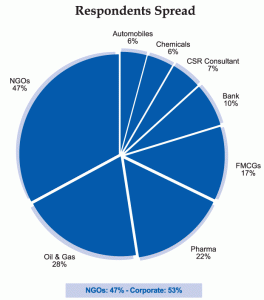
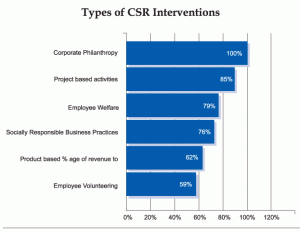
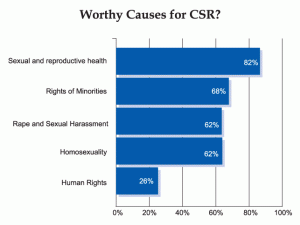
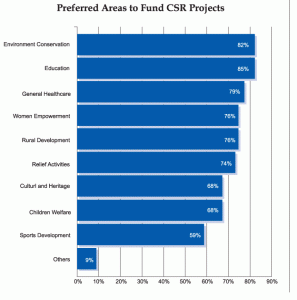
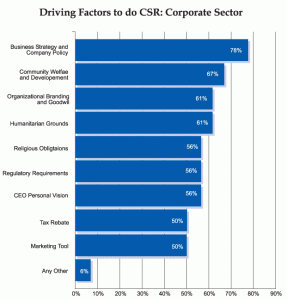
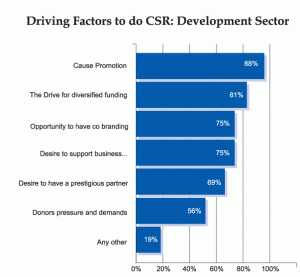
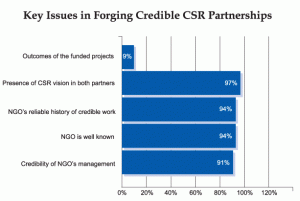




Energy has become one of the most significant concerns in the 21st century. The need for energy has continued to increase and it has become difficult to meet this demand. Coal is poised to be one of the most important sources of energy but it is facing the challenge of environmental impact. To ensure that coal becomes an important source of energy in the world, it is important to put in place a framework for sustainable coal mining. The government should play bigger roles in regulation of coal mining and ensure environmental impact assessment is carried out first. The government should shut down mines if they continuously ignore the law. Fines are not sufficient deterrents for coal mines to supply with safety standards and protect the people and the planet.
For more information visit http://www.triplebottomlineapproach.com and http://www.democracyandconflict.com.
The study perhaps has taken a narrow view of CSR in my opinion. It’s titled ‘tracks and trends in csr practices’ where as it mostly covers the community and development part – there is no mention of corporate governance, role of communication and most importantly the value chain.
‘Worthy causes for CSR” just contains opinon as the next heading “Preferred areas of funding” clearly shows that ‘motivation’ for worthy causes is just plain talk – not even a single area is overlapping between the two.
Inclusion of such a large number of NGOs (47%) in survey shows inclination towards community development aspect of CSR only. Governance, strategy, environmental performance, workplace, employees – areas rarely requiring partnerships with NGOs haven’t got due share.
I find ‘types of CSR interventions’ confusing. The options don’t appear to be mutually exclusive. I also didn’t get “Driving factors to do CSR- Development Sector” – Development sector does ‘corporate’ social responsibility? or was it meant as reasons for development sector to get involved in CSR projects? I am also not sure what is meant in “commentary” when it says: “To ensure success of CSR funding, they have set up foundations /trusts” – isn’t this extremely narrow view of foundations/ trusts? The conclusion in third paragraph of commentary about necessity of partnerships is clearly a result of loaded questions. High score of regulatory requirement (56%)on “Driving factors” is also result of sample bias- 28% respondents are from Oil& Gas sector where social spending is mandatory – the sector does little in concealing the motivation and openly calls it social “obligation”.
The part on forging partnerships is really good. Key issues highlighted are surely important and well identified.